Introduction
Nursery pigs often experience a lag in growth performance when transitioning from sows’ milk to dry feed during weaning. The lag is caused by several factors, including the dietary and environmental stresses associated with weaning. This post-weaning challenge can be associated with suppressed performance, diarrhea, and other intestinal health problems. While compensatory gain may occur as pigs become accustomed to solid feed, previous stresses may diminish the pig’s growth capacity throughout its lifetime. Therefore, feeding strategies and technologies are implemented both pre- and post-weaning to combat growth challenges in the early nursery stages.
Creep feeding, or supplementing suckling pigs with dry feed, has been thought to improve post-weaning feed intake by providing pigs with an opportunity to become acclimated to feed prior to weaning. Bruininx et al. (20023) found pigs that consume creep feed are quicker to consume feed post-weaning and experience improved growth performance. Additionally, van den Brand et al. (20134) demonstrated that pigs fed a large pellet pre-weaning, as compared to a small pellet, had improved BW gain, ADFI, and improved F/G post-weaning. These data are particularly interesting and warrant further investigation because creep feed is most typically provided as a small pellet. The objective of this study was to compare the effects of creep feed pellet diameter on suckling pig performance and subsequent nursery growth performance.
Procedures
The Kansas State University Institutional Animal Care and Use Committee approved the protocol used in this experiment. The trial was conducted at the Kansas State University Swine Teaching and Research Center in Manhattan, KS. All diets were manufactured at the O. H. Kruse Feed Technology Innovation Center at Kansas State University using a 30-horsepower pellet mill (30 HD Master Model, California Pellet Mill, San Francisco, CA). Conditioning temperature was 155° F and retention time was 45 seconds.
A total of 26 sows and their litters (PIC 327 × 1050, initially 7.1 lb and 10 d of age) were used in a 31-d experiment. On d 10 of the suckling phase, sows and their litters were allotted to one of two dietary treatments by parity and pig weight in a completely randomized design, with 13 replications per treatment. Pigs were fed the same creep feed formulation that was pelleted using either a 1/8 in. (small) or 1/2 in. (large) die (Table 1). Length to diameter ratios for the small and large dies used were 1/8 in. × 1 . in. and 1/2 in. × 3 in., respectively. Each farrowing crate contained a creep feeder (Rotecna Mini Hopper Pan, Rotecna SA, Spain) that allowed piglets ad libitum access to creep feed. Individual pig weights and creep feeder weights were taken on d 10, 14, 17, and 21 of suckling to determine ADG, ADFI, and F/G.
Table 1. Diet composition (as-fed basis)1
Chromic oxide was included in the diets as a fecal marker. Rectal swabs were taken at 0700 and 1600 on d 14, 17, and 21 to detect the presence of chromic oxide. Swabs were considered positive when green color was detected by visual inspection. A positive swab indicated that the pig was consuming creep feed, and that pig was subsequently considered an “eater”.
Upon weaning at d 21, which coincides with nursery d 0, 331 pigs (initially 14.1 ± 3.0 lb) previously on creep feed treatments while suckling were pooled within suckling treatment for re-allotment in the nursery. Pigs were allotted in the nursery according to BW and litter, and balanced by previously established eater/non-eater status and gender. Phase 1 (d 0 to 7 post-weaning) treatment diets were the same diets as fed during the suckling period, with 50% of the pigs remaining on their previously allotted pellet diameter treatment. The other 50% of pigs were re-allotted to the opposite pellet diameter treatment in the nursery, creating a 2 × 2 factorial with the main effects of previously fed creep feed pellet diameter and current nursery feed pellet diameter. A common meal Phase 2 diet (d 7 to 21) was fed to all pigs. In the nursery, there were 14 replicate pens per treatment, with 5 or 6 pigs per pen.
In the nursery, pigs were weighed and feed disappearance was determined on d 0, 4, 7, 14, and 21. Daily feeder weights were also taken from d 0 to 7 to determine the daily consumption of feed post-weaning. Each pen (4 × 5 ft) contained a 4-hole, dry self-feeder and a nipple waterer to provide ad libitum access to feed and water.
Data were analyzed using the PROC MIXED procedure of SAS (SAS Institute, Inc., Cary, NC). Litter was considered the experimental unit during the suckling portion of the study, and pen was considered as the experimental unit during the nursery portion of the study. Pairwise comparisons were used to determine differences between treatments during the suckling phase. For analysis during the nursery phase, pre-planned contrasts were utilized to determine the interaction between creep feed pellet diameter and current nursery-feed pellet diameter, as well as the main effects of creep feed pellet diameter and nursery-feed pellet diameter on nursery performance. Results were considered significant at P ≤ 0.05 and tendencies between P > 0.05 and P ≤ 0.10.
Results and Discussion
Dietary treatment analysis showed that formulated nutrient levels generally matched analyzed concentrations. Physical diet analysis showed that bulk density of small pellet and large pellet treatments were similar. However, the large pellet had reduced pellet durability index and increased percentage of fines (Table 2).
Table 2. Physical analysis of diets (as-fed basis)1
During the suckling phase (d 10 to 21 after birth), litters of pigs fed the large creep feed pellet had decreased (P < 0.03) pre-weaning mortality. Litters of pigs fed the large creep feed pellet tended (P < 0.06) to have greater litter BW gain and litter ADG, however, with no significant differences observed in pig BW gain, total, or ADG, this can likely be attributed to mortality observed in pigs fed the large creep feed pellet. No significant differences were observed in pig BW, pig BW gain, or within litter CV. No difference was observed in the percentage of pigs identified as creep feed eaters between pigs fed small (58%) or large (59%) pellets. From d 17 to 21 of suckling, pigs fed the large creep feed pellet had increased (P < 0.05) average daily creep feed intake, but only tended (P < 0.10) to have increased average daily creep feed intake during the overall suckling phase.
During the nursery phase, there were no interactions for Phase 1 (d 0 to 7) when experimental diets were fed. However, during the common period (d 7 to 21), pigs previously fed a large pellet tended (P < 0.09) to have improved ADG compared to those fed a small nursery pellet when the creep feed treatment was a small pellet, but had decreased ADG compared to those fed a small nursery pellet when the creep feed treatment was a large pellet. Feeding a large pellet during the nursery phase, regardless of previous creep feed treatment, increased (P < 0.05) ADFI from d 0 to 4, 4 to 7, and 0 to 7. Additionally, feeding a small pellet during the suckling phase, regardless of nursery treatment, tended (P < 0.06) to increase ADFI from d 0 to 4. Pigs fed the large pellet in the suckling phase, regardless of pellet diameter fed during the nursery phase, had improved (P < 0.01) ADG from d 0 to 7. However, pigs fed the small pellet in the suckling phase, regardless of pellet diameter fed during the nursery phase, tended (P < 0.08) to have increased ADFI from d 14 to 21. When pigs were fed a common diet from d 7 to 21, as well as during the overall (d 0 to 21) nursery period, F/G was improved (P < 0.01) in pigs fed a large pellet during the suckling phase.
Results from this study indicate that feeding a large creep feed pellet may be correlated with reduced pre-weaning mortality. However, there is no improvement on individual suckling pig growth performance or percentage of pigs eating creep feed between feeding a small- or large-diameter pellet. Feeding a large creep feed pellet improved F/G for the entire nursery phase, and feeding a large nursery pellet increased ADFI during the first week in the nursery. In conclusion, no benefit was observed in using a small pellet for the creep feed or initial nursery diet, with any performance advantages found favoring the larger diameter pellet.
This article was originally published in Kansas Agricultural Experiment Station Research Reports: Vol. 1: Iss. 7. https://doi.org/10.4148/2378-5977.1118. This is an Open Access article licensed under a Creative Commons Attribution 4.0 License. Table 3. Chemical analysis of diets, (as-fed basis)1,2
Table 4. Effects of creep feed pellet diameter on suckling pig growth performance1
Table 5. Effect of creep feed pellet diameter on percentage of suckling pigs consuming
Table 6. Interactive effects of creep feed and nursery feed pellet diameter on feed intake from d 0 to 7 after weaning1,2
Table 7. Main effects of creep feed and nursery feed pellet diameter on feed intake from d 0 to 7 after weaning 1,2
Table 8. Interactive effects of creep feed pellet diameter and nursery pellet diameter on nursery pig growth performance 1, 2
Table 9. Main effects of creep feed pellet diameter and nursery pellet diameter on nursery pig growth performance1,2
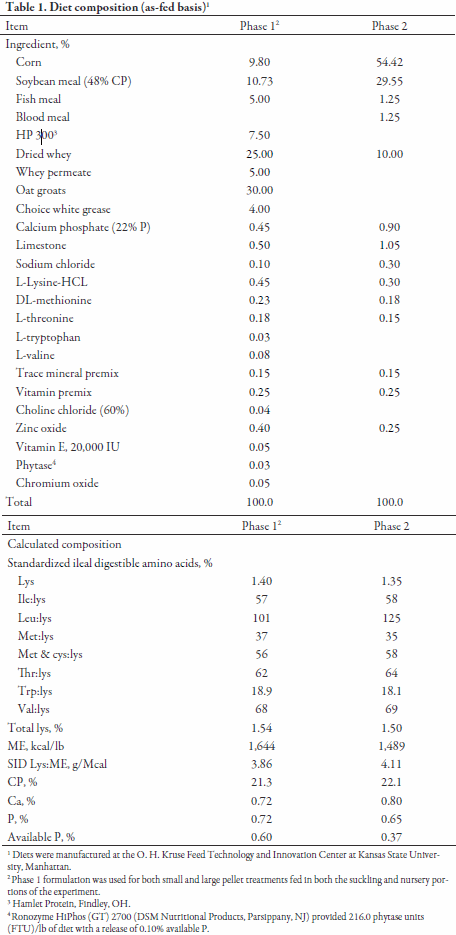

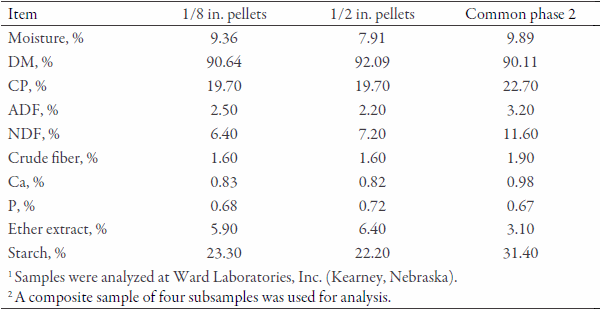
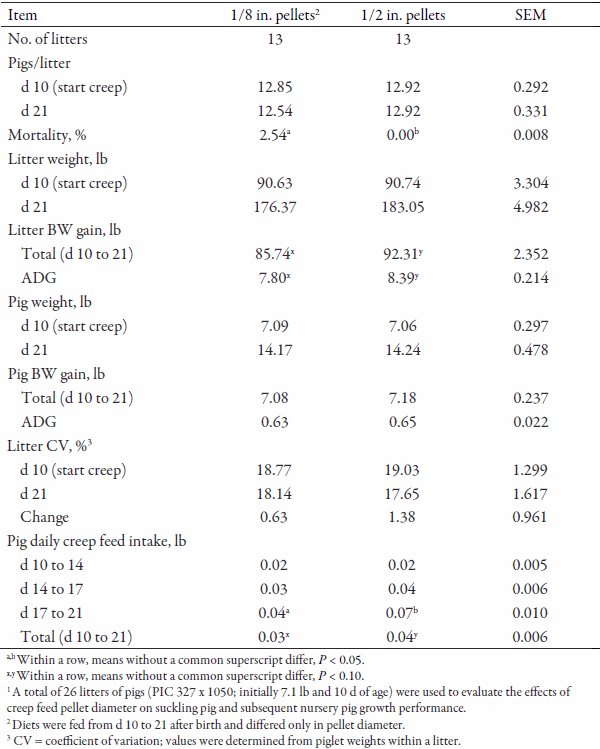
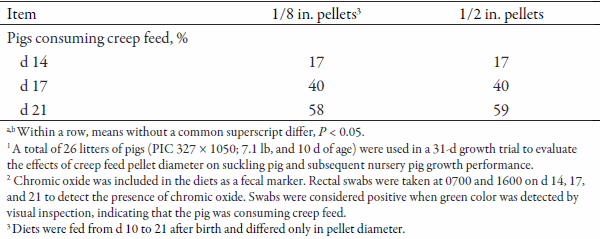
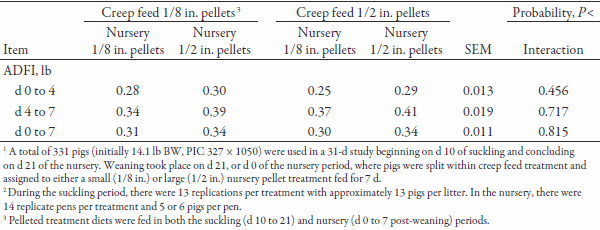

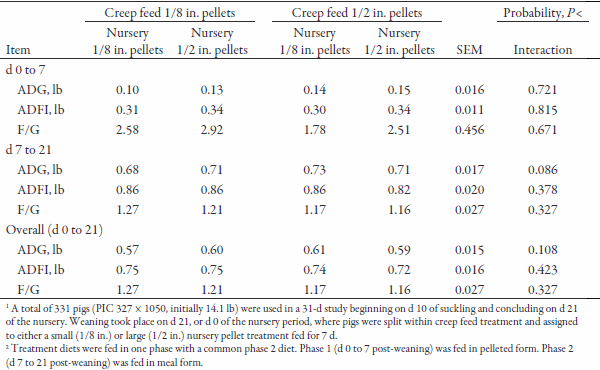











.jpg&w=3840&q=75)